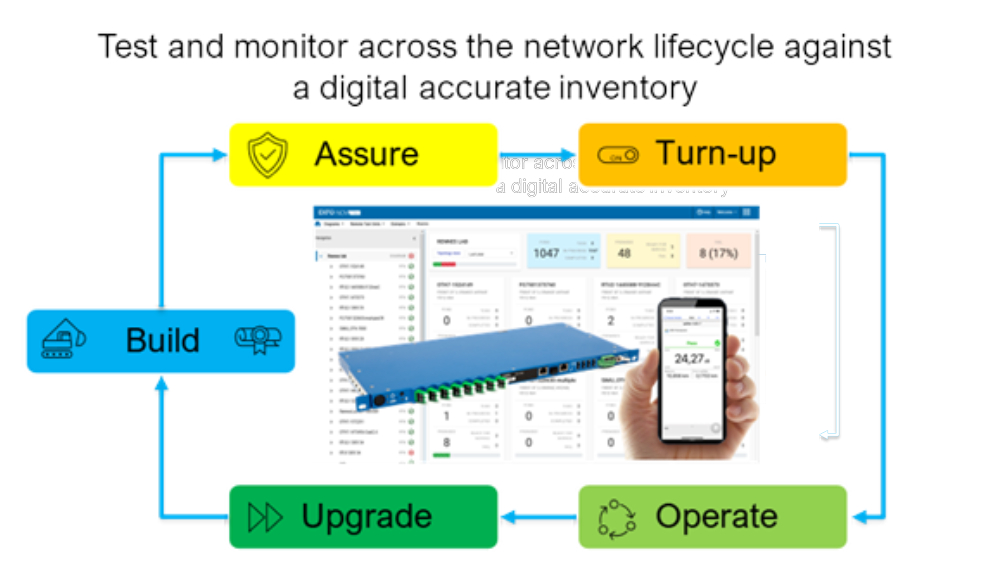Managing fiber networks throughout their lifecycle: the role of remote fiber testing and monitoring
In an era where seamless connectivity is critical to all, the reliability of your fiber network is non-negotiable. To maintain the competitive edge, it is imperative to implement robust testing and monitoring strategies throughout the network lifecycle, solidly anchored by a precise digital inventory. This is where remote fiber testing and monitoring (RFTM) takes center stage, providing a comprehensive approach to managing fiber networks from inception to ongoing operation and upgrades. Let’s consider the benefits of RFTM for each phase.
Build phase : setting a strong foundation
During the build phase, meticulous attention to detail is necessary. RFTM allows you to track the progress and quality of every link in the network. By testing 100% of the links, you gain valuable insights into the build process, ensuring that the highest standards are met. Moreover, of the capability of generating digital birth certificates in relation to each fiber asset creates a powerful reference point for future maintenance and upgrades. Finally, integrating test equipment within the network can also have significant mutual benefits when collaborating with contractors by standardizing the way tests are executed. This enables testing as a one-man job and automates data collection and reduces contract costs while letting contractors spend more time on building and less on testing and reporting. The positive outcomes for this phase are manifold:
- accelerated build and monetization
- elevated quality standards
- cost reduction
- creation of a detailed digital inventory

Assure and turn-up phases: ensuring seamless activation
This phase is a critical juncture in the lifecycle of optical networks, especially considering the potential for significant delays between the end of the build and the actual turn-up/activation— which can stretch for weeks or even months. During this crucial period, RFTM plays a pivotal role through continuous monitoring to confirm the network’s readiness for activation. When needed, post-repair tests are conducted to validate the quality of the links, effectively updating the baseline for future reference. These proactive measures not only mitigate the risk of turn-up delays but also lead to a substantial reduction in operational expenses associated with failed activations . By assuring the network’s integrity in the interim, you are not only safeguarding against potential hiccups but also ensuring a seamless transition when the turn-up finally occurs. Additionally, RFTM provides the capability of generating birth certificates relating to the activation, proving end-to-end performance of specific customer links at installation.
Operate and upgrade phases: sustaining optimal performance
In the operate phase, RFTM offers a suite of tools for monitoring and on-demand troubleshooting. Continuous monitoring allows for the prompt identification and location of degradations in the network. Post-repair tests once again validate the quality of the links, ensuring they meet the required standards. Also, by monitoring trends over time, unprecedented insights can be harnessed into the network’s changing performance. This helps to identify opportunities for preventive maintenances which can be planned at less disruptive times compared to reactive maintenance while being typically less expensive (planned maintenance vs. urgent repair). Monitoring during the operation also empowers you to assess current capacity against new requirements, facilitating timely upgrades to new technologies. The overall outcomes include:
- reduced downtime for subscribers (fewer outages, which last for shorter periods)
- lowered operational costs related to fault diagnosis and location
- streamlined / cost-effective upgrades
Conclusion: elevating network performance and profitability
By incorporating RFTM into each lifecycle phase from the very beginning, –it is possible to unlock a host of benefits. From faster build and monetization, to heightened quality standards and reduced costs—RFTM sets the stage for a robust and reliable network in a context where scalability is not hampered by labor shortages. Moreover, by preventing turn-up delays, minimizing operational expenses, and facilitating seamless upgrades, RFTM ensures that your network remains at the forefront of connectivity technology.
Embrace RFTM and drive up network performance and profitability today!




